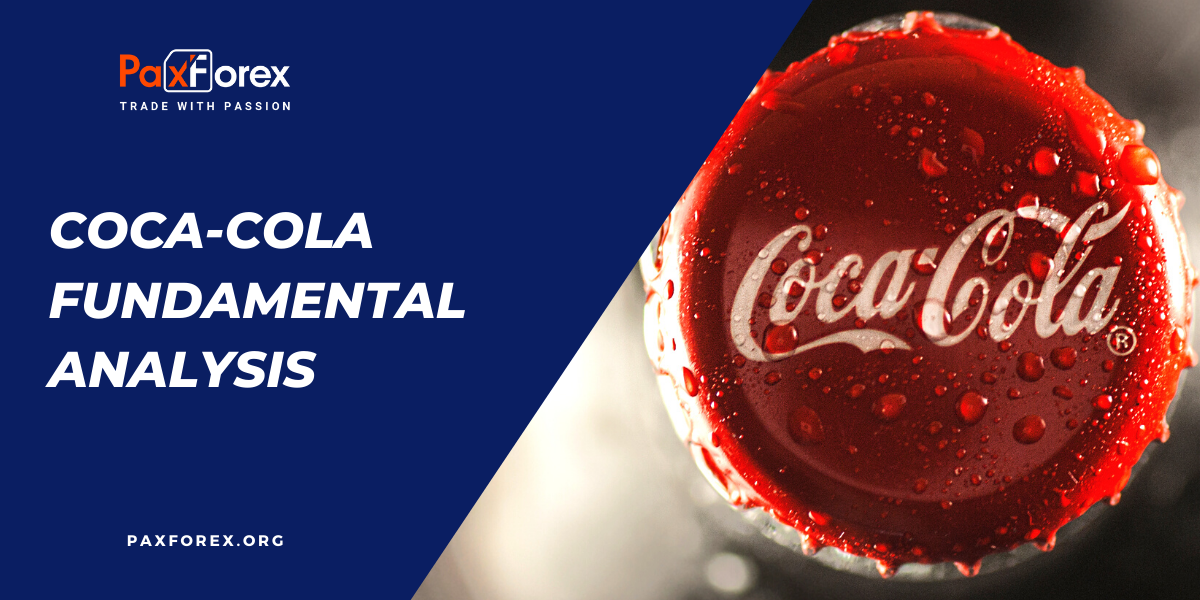
Source: PaxForex Premium Analytics Portal, Fundamental Insight
The profound impact of The Coca-Cola Company on the wealth and success of legendary investor Warren Buffett cannot be overstated. More than three decades ago, Buffett made a strategic move, acquiring a multibillion-dollar stake for his company, Berkshire Hathaway. Remarkably, he has steadfastly retained this investment over the years. Thanks to the combined effects of appreciation and dividend growth, Buffett now enjoys an impressive annual dividend income exceeding $700 million.
Despite the substantial financial gains attributed to Coca-Cola, the stock has surprisingly lagged behind the average returns of the broader stock market in the past decade. Even when factoring in the reinvestment of dividends, its performance falls notably short of market averages, much to the disappointment of shareholders.
Curiously, despite this prolonged underperformance, investors still maintain a favorable view of this Dividend King, a sentiment likely bolstered by Buffett's unwavering support. However, amid the steadfast loyalty to Coca-Cola in the past decade, there is another stock that has quietly surged, increasing in value tenfold. Intriguingly, this stock is intricately linked to Coca-Cola, yet its impressive growth seems to be discreetly hiding in plain sight.
In Coca-Cola's annual report, the emphasis is on owning, licensing, and marketing numerous beverage brands, with no explicit mention of bottling and distribution. This critical aspect is outlined in the subsequent paragraph, highlighting the company's reliance on an extensive network of independent bottling partners, distributors, wholesalers, retailers, and its consolidated bottling and distribution operations.
Enter Coca-Cola Consolidated, a discreet player based in North Carolina. This company holds the rights to Coca-Cola products and certain offerings from Keurig Dr Pepper and Monster Beverages. Functioning as a maker, distributor, and seller, Coca-Cola Consolidated supplies a variety of beverages to grocery stores, convenience stores, and outlets across 14 states.
Despite 86% of its sales volume being attributed to Coca-Cola products, the stock returns of Coca-Cola and Coca-Cola Consolidated over the past decade tell a different story. Around ten years ago, Coca-Cola Consolidated underwent a transformative phase, divesting certain operations while acquiring new distribution regions, rights, and facilities. This restructuring initially led to a decline in profit margins, but after its completion in 2018, profits experienced a notable resurgence.
Benefiting from consistent consumer demand for popular beverages and operational discipline, Coca-Cola Consolidated has seen improved profitability. Focused on prudent long-term capital allocation, the company has significantly reduced its debt over the last five years, achieving a net cash position for the first time in nearly four decades.
While future revenue growth may be modest, with recent increases primarily driven by price adjustments, Coca-Cola Consolidated maintains confidence in maintaining its profit margins. This resilience allows the company to strengthen its financial position through debt reduction or returning value to shareholders via increased quarterly dividends.
Trading at just 15 times its trailing earnings, Coca-Cola Consolidated's stock appears comparatively inexpensive, especially when juxtaposed with Coca-Cola's stock trading at almost 24 times earnings. Despite expectations that the extraordinary business transformation driving past returns may not be replicated, the company's stability and robust financial standing make it an attractive investment. While a 1,000% return over the next decade may seem unlikely, the combination of a low valuation, financial strength, and positive cash flows positions Coca-Cola Consolidated as a potentially better buy than Coca-Cola stock in the current landscape.
As long as the price is above 56.00, follow the recommendations below:
- Time frame: D1
- Recommendation: long position
- Entry point: 58.27
- Take Profit 1: 59.00
- Take Profit 2: 61.00
Alternative scenario:
If the level of 56.00 is broken-down, follow the recommendations below:
- Time frame: D1
- Recommendation: short position
- Entry point: 56.00
- Take Profit 1: 55.00
- Take Profit 2: 54.00













